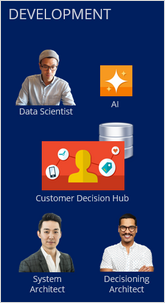
Prediction lifecycle
Prediction lifecycle
Learn how a data science team implements changes to models and predictions in the business operations environment through the Business change pipeline.
Video
Transcript
In the implementation phase of a Pega Customer Decision Hub™ project, the project team sets up the system in the development environment, which serves as the system of record for the application. A Data Scientist then configures the out-of-the-box predictions and creates any additional predictions that are needed.
Once the development reaches a mature state, the application is deployed through an initial pipeline to higher environments, including staging for additional testing, business operations for initiation and implementation of changes, and the live production environment. After the initial deployment, all environments are synced.
The change management process begins in the business operations environment with the creation of the first revision in the 1:1 Operation Manager portal. The project is considered ready to go live once the first version of the application is complete and all tests are successful.
The production environment is the main system that propagates the next best actions to external channels, collects customer responses, and is where AI learning takes place. The data science team uses the production environment for live monitoring of key model performance indicators, and the system generates notifications on model performance, alerting the team when model behavior changes in the production environment.
The business operations environment is a replica of the production environment, but the system samples customer data through a data migration pipeline that is, for example, configured to run daily. The pipeline includes all model monitoring data.
Business users, including Data Scientists, use the business operations environment to initiate changes to actions, treatments, and other artifacts, including model and prediction rules. For example, when the technical team introduces a new class with new properties in the development environment and migrates these changes to higher environments through the Enterprise pipeline, the data science team can configure the new fields as potential predictors in an adaptive model rule.
The configuration of the system allows the Team Lead to initiate the change, create a change request that includes the adaptive model rule, and assign the change request to a Data Scientist. The Data Scientist processes the change request in Prediction Studio, and submits it for approval to the Team Lead.
The change request is part of the current revision. The revision manager deploys the revision through the Business Change pipeline to the development environment, and then from development to all other environments.
The new predictors are now available to the AI for learning in the production environment. The system records new customer responses, the models continue to learn, the Data Scientist resumes monitoring the adaptive models, and the life cycle of the ADM models continues.
You have reached the end of this video. What did it show you?
- The initial deployment of a Customer Decision Hub project involves configuring and creating predictions by a Data Scientist.
- After deployment, changes to existing predictions require a change request in the business operations environment.
- After the project goes live, the data science team uses the production environment to monitor the AI.
This Topic is available in the following Module:
- MLOps v4
If you are having problems with your training, please review the Pega Academy Support FAQs.
Want to help us improve this content?

